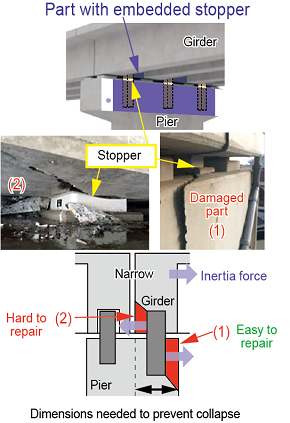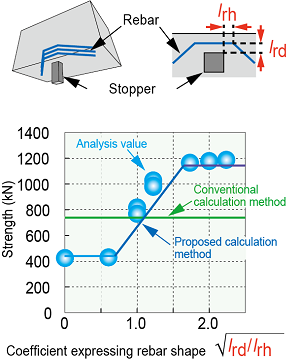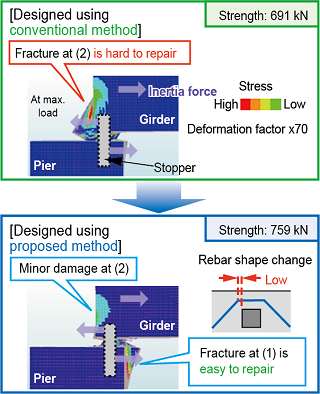2. Design method for bearing parts to control damage and improve restorability
Stoppers are embedded in the bearings of concrete bridges to prevent bridge collapse.
Damage to bearing parts with embedded stoppers was observed after many recent earthquakes in Japan, even when there was no collapse or safety threat (Fig. 1). In such cases, when damage occurs as a result of concrete peeling at the area shown in Fig. 1 (2) (girder end), which is narrower than shown in Fig. 1 (1) (pier front), repairing the bridge is difficult.
Therefore, controlling the damage to these difficult-to-restore areas is an effective way to shorten the time and cost of restoration work after an earthquake. In light of this, we proposed a method of calculating strength that is capable of assessing the influence of bending shape and configuration of rebar to improve the strength, without increasing the quantity of rebar in parts with embedded stoppers (Fig. 2).
With the conventional method, the same strength is calculated regardless of rebar bending shape and configuration, despite the fact that loading tests and FEM analysis show that strength varies according to these factors.
We therefore proposed a strength calculation method that takes into account the impact of rebar bending shape and configuration.
With the conventional design, damage may occur at the girder ends, which are difficult to repair, but we confirmed that the new method limits the damage to such hard-to-restore parts of a bridge to a minimal level, while at the same time ensuring equal or better strength than the conventional method (Fig. 3).
By eliminating the need to use heavy machinery for chipping concrete and erecting scaffolding, which are essential for repairing earthquake-damaged parts of a bridge, construction costs can be cut by 80%.
These findings will be reflected in the upcoming revision of the Design Standards for Railway Structures and Commentary (Concrete Structures).
Other Contents
- 1. Earthquake early warning method for the earthquake source fault regions
- 2. Design method for bearing parts to control damage and improve restorability
- 3. Method for verifying the restorability of railway structures considering small-and medium-scale earthquakes
- 4. Method for evaluating vehicle safety in strong winds using probabilistic risk assessment
- 5. Inspection of gaps by hammering slab track filling layers and prediction of deterioration
- 6. Method for estimating snow accretion and snow dropping of a train vehicle for investigating countermeasures against snow dropping
- 7. Method of applying image processing-based object detection and obstacle determination to safety applications
- 8. Support system for preventing a decline in alertness level of drivers
- 9. Phased array ultrasonic testing method for easy detection of flaws in bogie frame welds
- 10. Oil for axle-box for Shinkansen with excellent low-temperature performance and maintainability
- 11. Seat surfaces for minimizing injuries to passengers in the event of a collision
- 1. Earthquake early warning method for the earthquake source fault regions
- 2. Design method for bearing parts to control damage and improve restorability
- 3. Method for verifying the restorability of railway structures considering small-and medium-scale earthquakes
- 4. Method for evaluating vehicle safety in strong winds using probabilistic risk assessment
- 5. Inspection of gaps by hammering slab track filling layers and prediction of deterioration
- 6. Method for estimating snow accretion and snow dropping of a train vehicle for investigating countermeasures against snow dropping
- 7. Method of applying image processing-based object detection and obstacle determination to safety applications
- 8. Support system for preventing a decline in alertness level of drivers
- 9. Phased array ultrasonic testing method for easy detection of flaws in bogie frame welds
- 10. Oil for axle-box for Shinkansen with excellent low-temperature performance and maintainability
- 11. Seat surfaces for minimizing injuries to passengers in the event of a collision



